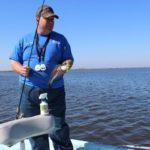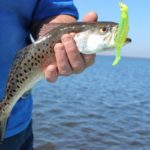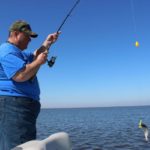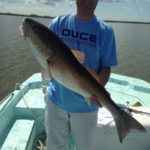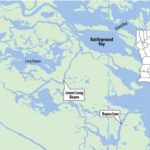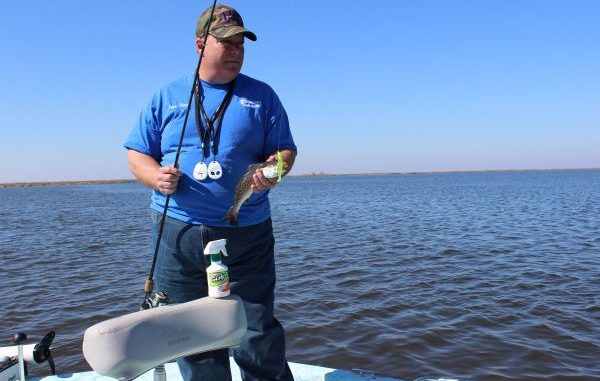
While many anglers are heading to open water in search of trout this month, those in the know point their boats to the Pointe a la Hache marsh, where even those with smaller boats can limit out.
Tucked cozily near the end of the inhabited east bank of Plaquemines Parish is Pointe a la Hache. And, largely forgotten by many, Beschel’s Marina is the gateway to incredibly fertile speckled trout fishing grounds virtually year round.
Inland bays produce trout from October through February when it’s temperate, and Oak River and other deeper water harbor them when it’s cold.
Small-boat anglers can fill their freezers during football season and March Madness, but may think it’s done for six months when the shrimp show.
But Capt. Chris Danos of Screaming Reels Fishing Charters said that — at least in the late spring — anglers need not fear the loss of opportunities for speckled trout.
Danos said small-boat anglers can limit their open-water exposure to just a few miles in the area and still have a chance to keep the wintertime hot sreak going.
“You can start really in Battleground Bay, which is pretty much a straight shot from the marina,” said Danos, adding that the body of water is actually within sight of Beschel’s.
From there, the target area for late-spring specks extends into Island Bay and Bay Law. The two bodies of water are farther out, but both still offer small-boat anglers two things they depend on, especially those new to the area: land protecting at least a portion of the water from steady winds and reasonable proximity to safe harbor should sudden storms pop up.
“That gives you some peace of mind when things go bad,” Danos said. “Even though there’s not near as much land as there used to be — there’s a place call Triple Pass, which is pretty much a double pass now — you do have some protection so that you’re not in the wide open when a storm comes up.”
Getting to safety is just a short hop.
“All of these places we’re talking about, there’s never a time where you can’t see the shoreline on the opposite side,” Danos said. “And really, they’re places that are close enough to the highway and the river that you’re going to have pretty good cell reception.
“That’s not to say you shouldn’t have a GPS on board — they’re cheap enough and are such good quality these days — but if you don’t you can find out where you are, (using a phone).”
Danos said apps such as Google Maps can accurately give you an idea of where you are with the familiar blue dot.
All of that is fine and dandy, but it doesn’t do much good unless the fishing holds up.
And Danos said the extra effort — down a winding, desolate river road — to get to the marina is more than repaid with quality speckled trout action, as well as bonus redfish and flounder on most trips.
“The trout fishing is going to be really good under the birds early in the morning. You never really know what size fish are going to be under them until you stop and try it,” Danos said. “There are schools where they’re all undersized, and there are schools where it’s going to be 50/50 keepers.
“But I rarely pass up an active set of birds.”
From there, Danos often lets a couple of factors determine where he’s going to set his trip in motion.
“All of the bays I’ve mentioned have oyster beds,” he said. “And all of those beds are marked by white sticks. The trout are usually going to congregate around the oyster beds, so I’ll position the boat upwind of a set of sticks and drift.”
Beschel’s has a reliable source of live shrimp in the late-spring months, but Danos said there are plenty of fish to be had for fishermen unable to or simply unwilling to pony up the cash for live bait.
“There’s plenty of people who don’t want to pay 30 cents a shrimp. Even the minnows are around the same price,” said Danos.
For an area largely and delightfully bereft of catfish — it’s even lacking substantial numbers of gafftopsail catfish, which push to the surface ravage pods of shrimp in other parts of the state — Danos said it’s still a good idea to calculate 50 shrimp per person if the goal is to secure a limit of speckled trout should the angler find the bite favorable.
“And even then, unless you’re really lucky or really experienced, you’re going to miss some fish, lose some fish, fish are going to undersized mixed in with keepers,” he said. “Pretty quickly you can look into the livewell and see that you’re really running low fast.”
Plenty of lures can tempt reef-dwelling trout, but Danos finds it hard to beat the familiar stand-by of a cork-and-soft plastic combination.
Frequently off-colored water due to persistent late-spring breezes and the river water coming from Mardi Gras Pass combine to make it hard to beat the triple threat of the sound of the popping cork, the ability of the fish to find the bait due to it being suspended in the water column and the flash of the bait, even when it’s not really a flash.
“One of the best baits the past few years has been a black beetle with a green tail,” Danos said. “It’s hard to explain why they like it, but it does seem to get more strikes on many days.”
Danos said the fact that the “green” sparkle beetle still draws attention against baits that are softer and have more tail action tells him there’s something to the composition of the bait that gives it a definitive fish-attracting quality when suspended under a cork.
“One thing that it might be is that it’s a much harder plastic than most of the paddle-tail baits,” he hypothesized. “Maybe when you pop it it echoes differently in the water than the softer baits.”
But Danos said there are plenty of days when more-active, paddle-tail baits such as the Matrix Shad produce more strikes.
“The good colors on those baits are the lemonhead and the shrimp Creole,” said Danos, adding that its similarly hard to pinpoint which color will produce on certain days, regardless of the water clarity and the limitless other factors dictating what the fish will respond to on a day to day basis. “It’s just something you’ve got to experiment with.”
One of the best ways to find fish — other than setting up on marked oyster beds — is to find old maps of the area.
“The old washed-out islands and points of the islands will still be there in some form on the bottom,” Danos said. “I know from experience where that bottom structure is, but someone with an old map can get a pretty good idea of where an old island is.
“The trout will congregate there.”
As far as tides go, Danos said that, while he prefers a falling tide, plenty of fish are caught on any moving water in the area.
He adds, however, that a strong outgoing tide can work wonders on a likely area containing fresh, cold, silty river water when the Mississippi runs high.
“That falling tide will wash that river water out and really clean up an area,” he explained. “If you give it a little time, it can really make a difference.”
Many anglers, however, might not have the benefit of letting Mother Nature do its work in preparing a piece of water for a gamefish feed.
Danos said that, in that case, the region’s larger islands and marsh can provide respite for fish and fishermen looking to beat the river water.
“If you can find some 8-foot depths in some canals and bayous in this area that aren’t too far inside, you can find clean water, even though it looks dirty on the surface,” Danos said. “Salt water is heavier than fresh water, and a lot of times the clean water will be around 3 feet underneath the surface — and that’s where you’ll find the fish.”
